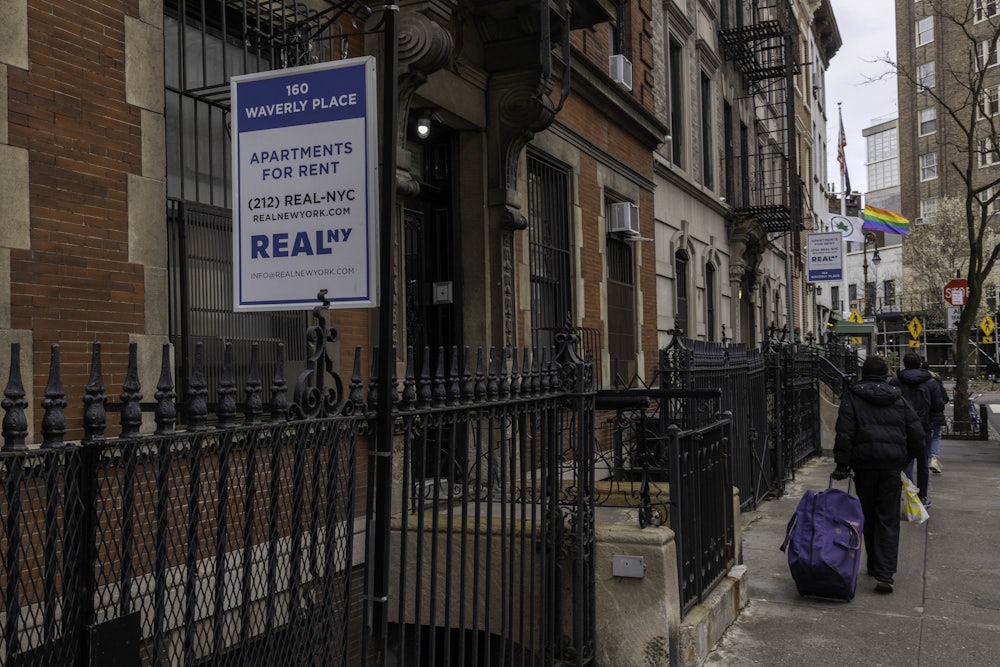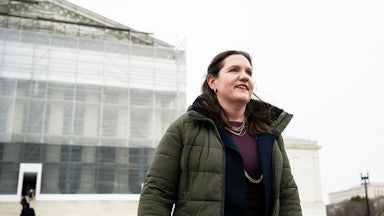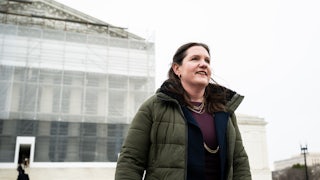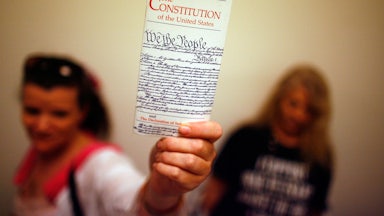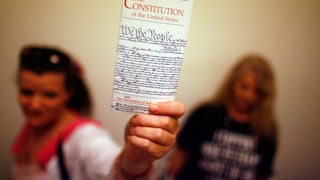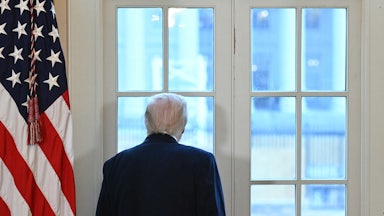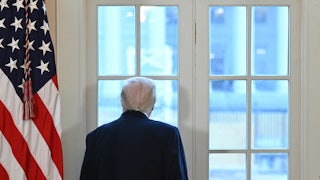The housing market is not great right now. High prices and higher interest rates are squeezing out first-time homebuyers. Rents are jumping in big cities as leasing companies try to offset their losses in the commercial real estate space. Americans hoping to find a better place to live are being asked to spend more and get less.
A group of New York landlords is now asking the Supreme Court to make things easier for them and harder for their tenants. The cases in question, 74 Pinehurst LLC v. New York and 335-7 LLC v. City of New York, seek to overturn New York’s Rent Stabilization Law, or RSL. The law, which was originally passed in 1969, received a series of major amendments in 2019 that added new protections for tenants who sought to maintain their current housing.
Those protections, the landlords told the justices in their petition for review, infringe upon their property rights to an unconstitutional degree. They hope to strike down the New York law in its entirety, a move that could not only have sweeping implications for New York City’s housing market but also call into question rent-control laws in other cities and states.
In the 74 Pinehurst LLC case, the plaintiffs are challenging provisions in the RSL that repeal a mechanism for landlords to remove their units from the rent-control scheme once monthly rent reaches a certain level, restrict landlords’ ability to take over more than one unit for personal or family use, and allow tenants to stay in an applicable unit for up to one year after a court determines that a tenant has breached their rental agreement.
“[The RSL] strips owners of their rights to use, possess, and exclude others from their property, including by forcing owners to continue renting to current tenants and their chosen successors indefinitely, barring owners from using their apartments as personal residences or housing for family members, and making it impossible for owners to use their property for purposes other than rent-stabilized housing,” the 74 Pinehurst plaintiffs argued in their petition for review. They claimed the 2019 changes were “relegating owners to caretakers of housing conscripted into the service of an off-budget public-assistance program.”
The 335-7 LLC case additionally claims that the new requirements, including one that allows family members to take over a rent-controlled lease, are unconstitutional. The landlord companies in that case claimed that the RSL had granted tenants a “unilateral right to renew their tenancies in perpetuity” as well as a “right of successorship in their leaseholds” that can transfer to family members. Both the state and the city framed things in less extreme terms. In the 335-7 LLC case, for example, the city noted that landlords still had ample protections after the 2019 changes.
“The RSL does not require a landlord to offer a vacant rent-stabilized unit for residential rental or dictate the landlord’s choice of tenant whenever a unit is vacant,” the city noted. “And a landlord may evict a tenant for cause, such as nonpayment of rent or misconduct. But the RSL generally requires a landlord to offer an existing, compliant tenant in a rent-stabilized apartment the opportunity to renew their lease upon lease expiration. And in certain instances, a landlord must offer a renewal lease to certain family members of an existing tenant who also reside in the unit.”
And in the 74 Pinehurst case, New York argued that the law is far less onerous than it was described in the petition for review. “The RSL permits changes in use of property in numerous circumstances and allows for evictions based on nonpayment, illegal activity, and other misconduct,” they told the justices in their brief. “The existence of these exits from the rental market alone defeats [the landlords’] facial physical takings claim.”
What does that claim mean? Under the Fifth Amendment’s Takings Clause, “private property” can’t be “taken for public use, without just compensation.” The clause is best known for its use in eminent-domain cases where the government compensates landowners when it seizes their land to build roads, railroads, and so on. But it can also apply in a set of contexts known as regulatory takings, where the government does not seize the property in its entirety but instead imposes a major burden on the ownership of it through regulatory action.
What counts as a regulatory taking is typically a complex legal question. But it is a much simpler one when a landlord leases housing to a tenant. In 1992, the Supreme Court heard a challenge to California’s Mobilehome Residency Law, which imposed new restrictions on when and how a landlord can evict tenants from their mobile homes. California real estate companies argued that the law infringed upon their property rights and violated the Takings Clause. The Supreme Court unanimously disagreed in Yee v. Escondido.
“[The landlords] voluntarily rented their land to mobile home owners,” Justice Sandra Day O’Connor wrote for the court. “At least on the face of the regulatory scheme, neither the city nor the State compels [them], once they have rented their property to tenants, to continue doing so. To the contrary, the Mobilehome Residency Law provides that a park owner who wishes to change the use of his land may evict his tenants, albeit with 6 or 12 months notice.”
In other words, so long as landlords had some ability to evict their tenants, the regulatory effect was not permanent enough to fall under the Takings Clause. “Put bluntly, no government has required any physical invasion of [the landlords’] property,” O’Connor noted. “[Their] tenants were invited by [them], not forced upon them by the government.” To that end, the Second Circuit Court of Appeals upheld the RSL in February. The three-judge panel noted that Yee allowed states to regulate the landlord-tenant relationship so long as it was not permanent.
“The [RSL] sets forth several bases on which a landlord may terminate a tenant’s lease, such as for failing to pay rent, creating a nuisance, violating the lease, or using the property for illegal purposes,” the panel wrote in the ruling in the 74 Pinehurst LLC case. “In light of this well settled case law that affords municipalities considerable flexibility in addressing landlord-tenant relationships, we conclude that Pinehurst has not plausibly alleged that the RSL effects a taking in all of its applications and that it is thus facially unconstitutional.”
In the 335-7 LLC case, the plaintiffs made similar arguments. (The cases were heard separately by the lower court because the RSL applied differently to the two sets of plaintiffs based on their ownership structures.) But the court again rejected them, ruling that under existing precedents, the state’s rent-control laws did not go too far. “In short, the fact that the law restricts a landlord’s ability to profit by converting a rent stabilized unit to a market-rate unit does not effect a physical occupation of the property,” the panel noted.
The panel also pointed out that the injuries claimed by the landlords were, at this point, still largely hypothetical ones. “More broadly, the landlords do not demonstrate that they attempted to use any of the available methods to exit the market or evict problematic tenants,” the panel concluded. “Unless and until they do so, it is impossible for us to determine if the RSL effects an as-applied taking.” In this circumstance, the panel noted, “exiting the market” meant converting the rent-controlled units into market-rate ones, not merely selling the building or transferring ownership of it.
The Supreme Court already dispensed with one challenge to the RSL earlier this week. In its Monday orders, the court declined to hear Community Housing Improvement Program v. City of New York, which challenged the RSL on similar grounds. (Again, because of the ownership structures, the case was technically separate from the other two.) But the justices declined to dismiss the other two petitions and instead scheduled them to be reconsidered in their weekly conference on Friday.
In recent years, the justices have shown some indications that they could broaden the law’s thinking on when regulations amount to a physical taking. In the 2021 case Cedar Point Nursery v. Hassid, for example, the court’s conservative members overturned a state law in California that gave union organizers free access to farmworkers without the farm owner’s permission under certain conditions. That access, the court concluded, violated the Takings Clause by limiting the owners’ right to exclude people from their property.
New York’s landlords are hoping the justices would be willing to apply that same principle to the landlord-tenant relationship, despite past Supreme Court rulings. New York and New York City, for their part, have told the court that they are trying to address unique circumstances in the nation’s largest city, where five million of its eight million residents are renters and space for new housing construction is hard to find. At stake is how far states and cities can go to protect their residents from rent hikes and evictions, and how far the Constitution protects landlords who want to maximize their own profits.
